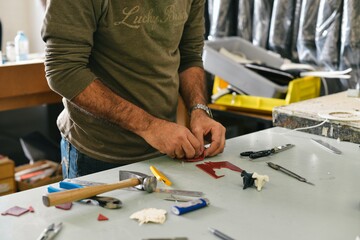How can we use forces to solve problems?

Workshop activities utilize various forces for solutions.

Workshop activities utilize various forces for solutions.
Forces are all around us, and they can be used to solve a lot of problems. For example, if you want to move a heavy box, you can use a force to push or pull it. If you want to stop a ball from rolling, you can use a force to push it in the opposite direction. And if you want to make a swing go higher, you can use a force to push it up.
Forces can also be used to solve problems in other ways. For example, engineers use forces to design bridges and buildings that can withstand strong winds and earthquakes. And scientists use forces to study how the world works, from the movement of planets to the behavior of atoms.
So, how can you use forces to solve problems? Here are a few ideas:
- If you have a heavy object that you need to move, try using a lever or a pulley. These tools can help you to increase the force that you can apply, making it easier to move the object.
- If you want to stop a moving object, try using friction. Friction is a force that opposes the motion of two objects that are touching each other. You can increase the amount of friction by making the surfaces of the objects rougher.
- If you want to make an object go faster, try using a ramp. A ramp is a sloping surface that can help to increase the speed of an object as it rolls or slides down it.
These are just a few examples of how forces can be used to solve problems. The next time you have a problem, try thinking about how you can use forces to solve it. You might be surprised at how many different ways there are to use forces to get things done!
How can the scientific method be used to solve problems?
The scientific method is a way for scientists to solve problems by asking questions and doing experiments. First, they observe something and ask a question about it. For example, a scientist might notice that plants grow better when they have sunlight. Then, they make a guess, called a hypothesis, about why something happens. For example, the scientist might guess that plants need sunlight to make food. Next, they test their hypothesis by doing an experiment. They set up two groups of plants - one with sunlight and one without - and see if the plants grow differently. Finally, they analyze their results and draw a conclusion. If the plants with sunlight grew better, then their hypothesis was correct. If not, they might need to come up with a new guess and do more experiments.
How can a lever be used to move a heavy object?
A lever is a long stick or bar that can help us move heavy objects. Imagine you have a big rock that you want to lift up. If you try to lift it directly with your hands, it might be really difficult. But if you use a lever, like a long metal rod, you can make it much easier. You can place one end of the lever under the rock and push down on the other end. This creates a force that lifts the rock up. It's like using a seesaw at the playground to make it easy to go up and down. The lever helps us apply more force, so we can move heavy things more easily.
How can friction help to stop a moving object?
Friction is a force that helps to stop a moving object. Let's say you're playing with a toy car on a smooth floor. When you push the car, it moves smoothly for a while, but then it starts to slow down and stop. That's because of friction. Friction happens when two objects rub against each other. In this case, the wheels of the toy car are rubbing against the floor. The rougher the surface, the more friction there is. Friction tries to stop the car from moving, so it helps us stop the car when we want to.
How does a ramp help make an object go faster?
A ramp is a slanted surface that can help objects go faster. Imagine you're playing with a toy car again, but this time you put a ramp in front of it. When you push the car up the ramp, it starts to go faster as it goes downhill. That's because the ramp helps to reduce the force of gravity pulling the car down. So instead of going straight down, the car goes down the ramp and gains speed. It's like sliding down a slide at the playground - it makes you go faster and it's lots of fun!
How do forces help engineers design strong bridges and buildings?
Forces help engineers design strong bridges and buildings that can withstand strong winds and earthquakes. When engineers build a bridge, they think about all the different forces that might act on it. They consider the weight of the cars and trucks that will drive on it, the force of the wind blowing against it, and even earthquakes that might shake it. By understanding these forces, engineers can design the bridge to be strong enough to withstand them. They use materials like steel and concrete to make sure the bridge can support the weight and resist the forces acting on it. That way, we can cross bridges and live in buildings that are safe and sturdy.

Workshop activities utilize various forces for solutions.